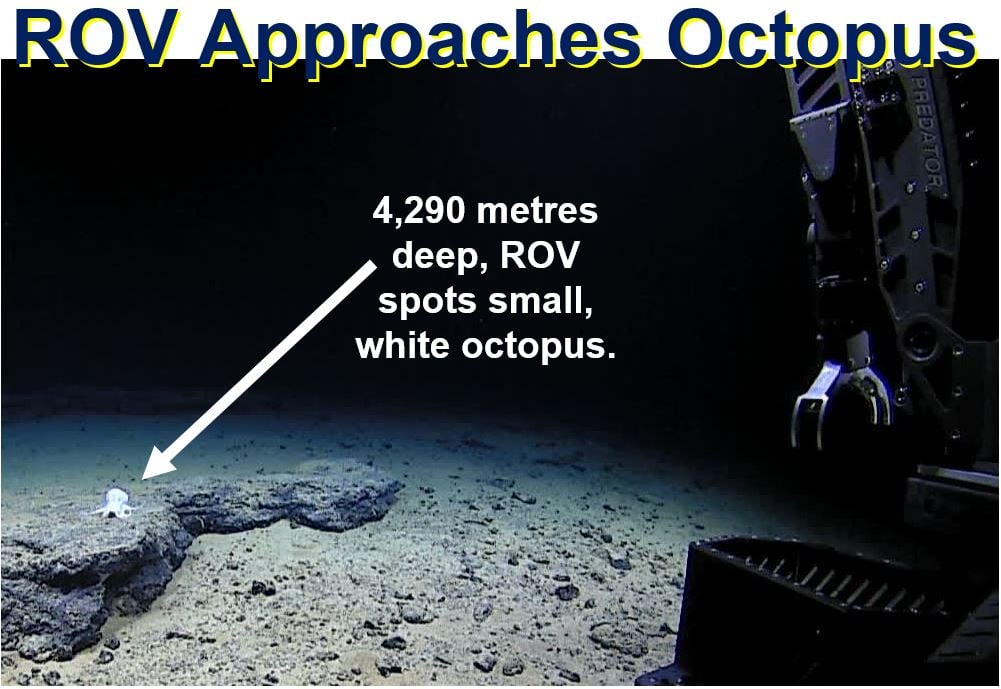Meet Casper the Octopus, which scientists discovered 4290 metres below the surface of the Pacific Ocean – an animal unlike anything ever published that looks eerily like a ghost. Researchers from the National Oceanic and Atmospheric Administration (NOAA), part of the US Department of Commerce, said it was the deepest observation on record for this type of cephalopod.
Cephalopods are active predatory mollusks of the large class Cephalopoda, such as octopuses, squid, the chambered nautilus and cuttlefish. They are the most mobile, intelligent and the largest of all mollusks.
Michael Vecchione, of the NOAA National Marine Fisheries Service – National Systematics Laboratory, and colleagues had been conducting the first operation dive of the Okeanos Explorer’s 2016 season, on 27th February, when they came across the fascinating animal, which they are pretty certain is a new species.
 When this picture was posted on social media websites, people suggested the little octopus should be called Casper (the friendly cartoon ghost) because of its lack of pigment cells. ( Image courtesy of NOAA Office of Ocean Exploration and Research, Hohonu Moana 2016)
When this picture was posted on social media websites, people suggested the little octopus should be called Casper (the friendly cartoon ghost) because of its lack of pigment cells. ( Image courtesy of NOAA Office of Ocean Exploration and Research, Hohonu Moana 2016)
Came across the ghost-like octopus by accident
Okeanos Explorer (R 337) is a converted US Navy ship, now an exploratory vessel for the NOAA. The researchers were exploring depths in excess of 4,000 metres northeast of Mokumanamana (Necker Island) in the Hawaiian Archipelago.
The dive was to collect data on whether a connection exists between Necker Ridge and Necker Island, a narrow feature on the seabed that extends more than 400 miles and protrudes past the current EEZ (exclusive economic zone) of the United States.
The researchers’ main objective was to collect geological samples on the ridge to help them determine whether they have the same composition as the samples that had been previously collected near Necker Island. Deep Discoverer, a remotely-operated vehicle (ROV), was also surveying biological communities in the area.
As the ROV travelled over a flat area of rock and sediment 4,290 metres down, it came a across a fascinating little octopod (octopus) resting on a flat rock dusted with a light coating of sediment.
 ROV Deep Discoverer approaches the hitherto unseen octopod at 4,290 meters depth. (Image courtesy of the NOAA Office of Ocean Exploration and Research, Hohonu Moana 2016)
ROV Deep Discoverer approaches the hitherto unseen octopod at 4,290 meters depth. (Image courtesy of the NOAA Office of Ocean Exploration and Research, Hohonu Moana 2016)
Small octopus unlike anything seen before
The remarkable little animal was unlike anything ever recorded or published before, and was also the deepest observation ever made for this type of mollusk.
There are two types of deap-sea octopods:
1. The Cirrate or finned octopus, also called the ‘dumbo’ octopus. It has fins on the side of its body and finger-like cirri associated with the suckers on its arms.
2. Incirrate octopods. These have neither fins nor cirri and look very similar to the common shallow-water Octopus.
Just one row of suckers per arm
The octopod, which was photographed in detail on this first dive, was found to be an incirrate. The researchers noticed that it had suckers in one row on each arm, rather than the usual two rows.
What made this animal stand out in the world of octopods was its lack of chromatophores – pigment-containing and light-reflecting cells which give an animal colour, typical of most cephalopods. Unlike other octopods, this one did not appear very muscular.
Its lack of chromatophores gave it a ghost-like appearance. When pictures of it were posted on social media sites, some readers suggested it should be called Casper, the friendly cartoon ghost.
Regarding this ghost-like creature, Vecchione wrote:
“It is almost certainly an undescribed species and may not belong to any described genus.”
Cirrate octopods have been seen at depths exceeded 5,000 metres. However, the deepest that incirrates have been observed was considerably less than 4,000 metres, that is, until now.
Vecchione added:
After seeing this observation, I contacted my colleagues Louise Allcock (currently on a British ship near Antarctica) and Uwe Piatkowski (from Germany) and they agreed that this is something unusual and is a depth record for the incirrate octopods.”
“We are now considering combining this observation with some other very deep incirrate observations by a German cruise in the eastern Pacific into a manuscript for publication in the scientific literature.”
Video – Casper the ghost-like octopus
In this video you can see the fascinating white octopus, probably a new species, moving about on the seabed at a depth of 4,290 metres.
